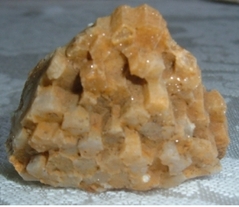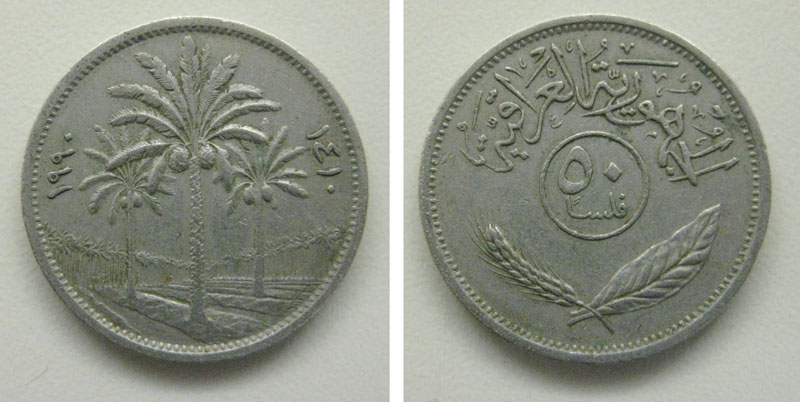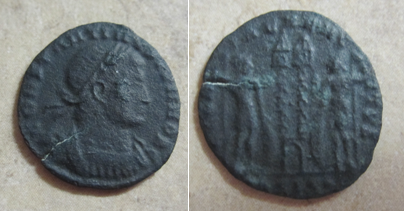October 18th, 2014 Brian Herzog
So this is an interesting question - and a situation where I got schooled in applying Occam's razor to research techniques.
A friend of mine at work had an unusual coin, and we wanted to find out what it was. It didn't have any English lettering on it, and no Arabic numbers, although it clearly looked like it was a coin from the Middle East or Asia, or maybe North Africa (however, the lack of Arabic numbers made me think it wasn't from an Arab country).
This came up late on a Friday, so I never got a chance to search for what it was. Over the weekend though, I did think about different approaches I could use to identify it:
- The failsafe always seemed to be just sitting down with our big world coin book, and going through it page by page looking for something similar
- I also thought a reverse image search would work - take a picture of the coin, run it through Google, and it should easily bring back exact matches
- Often when I'm trying to identify things, I type in whatever is written on them to match the exact phrase - since this coin isn't in English, I'd first have to install that font set and then hunt and peck until I found the right characters, and then search on the phrase or translate it
See, this is how a reference librarian approaches the problem (or at least, how I approached it).
When I got in a Monday, my coworker (who had worked Saturday) left a note on my desk identifying the coin as an Iraqi 25 Fils coin. Neat! So I asked her how she figured it out - hours pouring over the book? The reverse image search? She said,
No, I just searched for "palm tree coin" and it came right up.
Now that's how you research.
I honestly did feel a little dumb that searching like that didn't even occur to me - but I was able to redeem myself with dating it. It seemed like the coin had two dates written on it, which is odd to me, but also written in another language so I'd need to figure out how to translate them - which is also odd because I would have thought Iraq would use Arabic numbers. Also, being an Iraqi coin, I was curious if this was from the Saddam Hussein era or not.
Searching for "Iraq coin dates" brought up a website that explained that Iraq uses eastern Arabic numerals, and indeed two dating systems. One is the same modern years we use, and the other is
a Hejira date based on the lunar calendar and starting at the time Mohammed was alive (around 600 AD)
Using the translation table on the website,
I was able to work out this coin to be from 1990 / 1410. Saddam was President of Iraq from 1979 to 2003, so it was indeed a Saddam coin.
A couple other notes about this question:
- I was curious to see how well the reverse image search would work, so I tried it anyway - and it failed miserably. It seemed like it searched for anything round and silvery, which is just about every other coin in the world. Maybe it's not sophisticated enough yet to search for the image on the coin, or maybe my picture just didn't highlight the detail enough
- Maybe descriptive searches like "palm tree coin" don't occur to me because I'm so used to working with library catalogs. There really is no reason we shouldn't be able to search catalogs for "blue book with dog on cover," but since we can't I guess I don't think like that when approaching searches. It'd be a lot of effort to get that kind of metadata into library catalogs, but clearly crowdsourcing search data works for Google
- I had never heard of Eastern Arabic numerals, so it was fun to learn about something new
I liked this question a lot - and it wasn't even from a real patron!
Posted under Uncategorized | 9 Comments »
October 16th, 2010 Brian Herzog
This question was interesting, and in honor of the nature of this question, the alternate title for this post is "Reference Question of the Week - X/X/X."
One of my brothers came across some old Roman coins, and asked me if I could help identify them. The cleanest one he had looked like this (front and back):
He had found out about a book called Eric: The Encyclopedia of Roman Imperial Coins which should be a fairly comprehensive list, and wanted to know if my library had a copy. We don't, and according to WorldCat, it's not widely available at all. It is published by Dirty Old Books (which is the best possible name for a coin book publisher), and I found the full-text available as a PDF download [ZIP, 65MB!] from their website.
After it downloaded and I started flipping through it looking at the pictures, I was overwhelmed to see how many different Roman coins there were - but I guess that's what you get when you rule the earth for centuries.
So, I decided to try a different tactic. I went to Google Image search, and started searching on phrases that described the back of the coin - "roman coin two people tower," ancient coin two soldiers," etc. I started switching between both Images search and Web search, thinking the text descriptions in the Web search might give me more keywords, and that's exactly what happened with "coin soldiers standing tower."
On that search, the third return was titled Constantine, Roman Imperial Coins reference at WildWinds.com and had in the description "...two soldiers standing front, holding spears, heads turned inward at two standards between them..." which sounded promising. On that page I did a Ctrl+f for "two soldiers," and seemed to definitely be getting close. I also noticed that the words "GLORIA EXERCITVS" were printed on a lot of the coins. The writing on my brother's coin was too faint to read, but now that I knew what to look for, I could pick out the letters.
So I tried an image search for "GLORIA EXERCITVS" and hit the mother load.
Clicking on a few of those lead to http://www.romancoin.info which had a lot of information. I couldn't find the exact face on the front of the coin, but by scrolling down a bit, I found the exact coin back under the "Reverses" section of "Part 1 – The Era of Constantine the Great, his Sons and Rivals (320 – 337 A.D.)." So that seems to limit the coin's era and it also linked to a spreadsheet [XLS, 412KB] of all the coins that use that have that design on the reverse.
It didn't make much sense to me, but I sent all of this to my brother hoping that between the websites, spreadsheet, ERIC pdf and him using a magnifying glass to get more detail from the coin, he'd be able to identify it exactly.
But then again, narrowing it down to the reign of Constantine the Great might be enough. Unfortunately, it seems like these coins are fairly common and not very valuable. Still, pretty neat - I love my job.
Tags: ancient, coin, coins, dirty, id, identification, libraries, Library, old, public, Reference Question, roman
Posted under Uncategorized | Comments Off on Reference Question of the Week – 10/10/10
September 12th, 2009 Brian Herzog
 Here's another question with a patron bringing in an object and asking us to identify it - but this time was surprisingly easy.
Here's another question with a patron bringing in an object and asking us to identify it - but this time was surprisingly easy.
A patron walks up the the desk with some big plant parts and asks, "do you know what this is? It's a great big bush in my cucumber patch."
I'm not great at plant identification. While I was considering the best approach, the patron pulled out two more pods like those on the plant, except that they were dried and the seeds inside rattled when he shook them. He kept saying that he's never seen seed pods like that on a weed before.
Since I didn't have any great ideas, I just did a search for "weed seed pod bush." Much to my surprise, and to the patron's astonishment, a picture of his seed pods showed up on the second page.
Clicking into the page told us this plant was called "velvet leaf" so we did another search for velvetleaf to verify the information.
Between the websites we looked at and a few plant books we had on the shelf, the patron was torn between considering this an "invasive weed" or an "ornamental flower" (which reminded me of something a friend's dad once said: a weed is any plant that's growing where you don't want it to grow).
In the end, the patron decided to pull them all out, and happily left us what he brought in as "a bouquet for the staff." I was happy too, because this is one of those questions that could have taken all day to answer - it's nice to get lucky once in awhile.
Tags: Abutilon theophrasti, flower, id, identification, libraries, Library, plant, public, Reference Question, velvet leaf, velvetleaf, weed
Posted under Uncategorized | 1 Comment »
May 9th, 2009 Brian Herzog
 This question didn't come from a library patron - it came from my brother. He found a weird rock in his yard and emailed me pictures to see if I could help him identify it.
This question didn't come from a library patron - it came from my brother. He found a weird rock in his yard and emailed me pictures to see if I could help him identify it.
I don't know very much about rocks, but I looked through our rock identification books trying to match it to the pictures. I also tried looking online, and found lots of rock and mineral identification websites, but couldn't find anything that looked exactly like it.
It turns out, rock identification is more more involved than I would have thought. With plants, birds, trees, etc., a good field guide is enough. But with rocks, you need to determine the hardness, the composition, the luster, the cleavage, and more, and still an ID is not certain.
Since I was striking out, I did the only thing I could think of: ask someone smarter than me. I sent the photos I had to friends of mine who work as naturalists, and I posted the photos on PicAnswers.com.
PicAnswers.com is a question-and-answer website, but instead of just posting a question, you post a photograph of something you need identified. I had never used it before, but posting this this mystery rock was a perfect opportunity to try it out.
Only one person responded, but he identified it as Calcite, which is what my naturalists friends thought it was, too. Having the same answer coming from multiple sources is good, but when I looked up Calcite in our books and online, it doesn't really look like the rock my brother found - which shows why actually knowing what you're talking about is important.
If you've never used PicAnswers.com before, check it out. Some of the photos people post - everything from antique tools to skin blemishes - are bizarre but interesting.
Tags: identification, identify, libraries, Library, mineral, minerals, picanswers, picanswers.com, public, Reference Question, rock, rocks
Posted under Uncategorized | 5 Comments »
August 11th, 2007 Brian Herzog
Usually, when someone walks up to the desk with something in their hand and asks "can you help me find this," it'll be an easy question. 99 patrons out of 100 will have a piece of paper with a book's title, call number or ISBN written on it.
(In librarianese, this is called a "known-item search" - you know ahead of time exactly which item you're looking for.)
But, lucky me, I met #100.
A woman walked up to the desk and asked "can you help me find this," but she wasn't carrying a piece of paper. She had a little Tupperware container. I knew then that this was definitely an "unknown-item" search.
She took the lid off, and then repeatedly shook it, as if trying to get something inside to turn over. Eventually she righted what was inside, and held it out to me saying, "I found this in my basement and want to know what it is."
 What it was was an insect/centipedey thing. About an inch long, light brown, with a lot of very wispy legs, and two long antennae. I was surprised that it had survived the trip and all the shaking, but it was crawling around in there, along with a couple bits of dirt and brick. And she wanted me to help her identify it.
What it was was an insect/centipedey thing. About an inch long, light brown, with a lot of very wispy legs, and two long antennae. I was surprised that it had survived the trip and all the shaking, but it was crawling around in there, along with a couple bits of dirt and brick. And she wanted me to help her identify it.
I took her over to the 595's [?], and she started flipping through a few insect encyclopedias. However, not knowing the name of the bug, it became clear that identifying it was going to be tough. I showed her how to use the index to look up centipedes, told her to keep looking, and I went to do some internet searching.
Not knowing what to call this thing, I searched for "bug identification." I was hoping for a website that would guide me through the identification process by asking questions, such as "does it have more than six legs?," "does it have wings?," etc.
I went through the first page of search results without much success (despite promising domain names: whatsthatbug.com, insectidentification.org, bugguide.net, etc.).
But the final website on the first page paid off - Dave's Garden Bug & Insect Identification database. Instead of asking questions, it just had a long list of photographs. These were easy to scan through, and halfway down the page I spotted our quarry: of the family scutigeromorpha, commonly known as house centipedes.
The website didn't offer much additional information (here's more), but at least we learned what it was called (and read some humorous member comments, saying why they do or do not like this bug).
From that, we went back to the book shelf and quickly found a book with a section on them. Granted, the entire search process took more time than it took to read the section, but the patron was happy to know what it was - and that it's pretty harmless.
Unfortunately for this bug, I don't think riding around in a Tupperware container is at all harmless.
bug, centipede, centipedes, house centipede, identification, insect, libraries, library, public public libraries, reference, reference question
Tags: bug, centipede, centipedes, house centipede, identification, insect, libraries, Library, public public libraries, reference, Reference Question
Posted under Uncategorized | 7 Comments »





 What it was was an insect/centipedey thing. About an inch long, light brown, with a lot of very wispy legs, and two long antennae. I was surprised that it had survived the trip and all the shaking, but it was crawling around in there, along with a couple bits of dirt and brick. And she wanted me to help her identify it.
What it was was an insect/centipedey thing. About an inch long, light brown, with a lot of very wispy legs, and two long antennae. I was surprised that it had survived the trip and all the shaking, but it was crawling around in there, along with a couple bits of dirt and brick. And she wanted me to help her identify it.